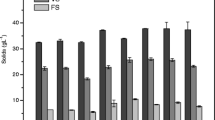Abstract
We compared two H2O2 oxidation methods for the treatment of industrial wastewater: oxidation using Fenton's reagent [H2O2/Fe(II)] and microwave irradiation. Both methods were applied to the treatment of synthetic phenol solutions (100 mg L−1) and of an industrial effluent containing a mixture of ionic and non-ionic surfactants at high load (20 g L−1 of COD). The effects of initial pH, initial H2O2 concentration, Fenton catalyst amount and irradiation time were assessed. According to the oxidation of phenol, it has been found that the oxidation by Fenton's reagent is dependent on the pH, contrary to the microwave system, which is not influenced by this parameter. For both systems, a limiting amount of oxidant has been found; above this point the oxidation of phenol is not improved by a further addition of peroxide. The oxidation of the industrial surfactant effluent has only been successful with the Fenton's reagent. In this case, large amounts of ferrous ions are necessary for the precipitation of the ionic surfactants of the effluent, followed by the oxidation of the non-ionic constituents of the solution.





Similar content being viewed by others
References
Adams CD, Kuzhikannil JJ (2000) Effects of UV/H2O2 preoxidation on the aerobic biodegradability of quaternary amine surfactants. Water Res 34:668–672
Bielski BHJ, Cabelli DE, Arudi RL, Ross AB (1985) Reactivity of HO2/O2 − radicals in aqueous solution. J Phys Chem Ref Data 14:1041–1100
Bishop DF, Stern G, Fleichman M (1968) Hydrogen peroxide catalytic oxidation of refractory organics in municipal waste waters. Ind Eng Chem Process Des Dev 7:110–117
Bolte M, Asif A, Gilles M (2000) Degradation of sodium 4-dodeylbenzenesulphonate photoinduced by Fe(III) in aqueous solution. Chemosphere 41:363–370
Carey JH (1992) An introduction to advanced oxidation processes (AOP) for destruction of organics in wastewater. Water Pollut Res J Can 27:1–21
Eisenhauer HR (1964) Oxidation of phenolic wastes: I. Oxidation with hydrogen peroxide and a ferrous salt reagent. J Water Pollut Control Fed 36:1116–1128
Esplugas S, Chamarro E, Marco A (2001) Use of Fenton reagent to improve organic chemical biodegradability. Water Res 35:1047–1051
Glaze W (1995) Chemical oxidation. Water quality treatment. A handbook of community water supplies, 4th edn. McGraw-Hill, New York
Kolthoff IM, Medalia AI (1949) The reaction between ferrous iron and peroxides. II. Reaction with hydrogen peroxide in the presence of oxygen. J Am Chem Soc 71:3784–3788
Litvintsev IY, Mitnik YV, Mikhailyuk AI (1993) Kinetics and mechanism of catalytic hydroxylation of phenol by hydrogen peroxide. I. General relationships of process variables. Kinet Catal 34:68–72
Luis AM de (1999) Degradation of phenolic compounds in solution with hydrogen peroxide: modelizing of radicals' generation systems. PhD Thesis, University of the Basque Country, Bilbao
Perales JA, Manzano MA, Sales D, Quiroga JM (1999) Linear alkylbenzene sulphonates: biodegradability and isomeric composition. Bull Environ Contam Ecol 63:94–100
Pignatello JJ (1992) Dark and photoassisted Fe(III)-catalyzed degradation of chlorophenoxy herbicides by hydrogen peroxide. Environ Sci Technol 26:944–951
Rivas FJ, Kolackzkowski TS, Beltran FJ, McLurgh DB (1999) Hydrogen peroxide wet air oxidation of phenol: influence of operating conditions and homogeneous metal catalysts. J Chem Technol Biotechnol 74:390–398
Author information
Authors and Affiliations
Corresponding author
Rights and permissions
About this article
Cite this article
Sanz, J., Lombraña, J.I., De Luis, A.M. et al. Microwave and Fenton's reagent oxidation of wastewater. Environ Chem Lett 1, 45–50 (2003). https://doi.org/10.1007/s10311-002-0007-2
Accepted:
Published:
Issue Date:
DOI: https://doi.org/10.1007/s10311-002-0007-2




